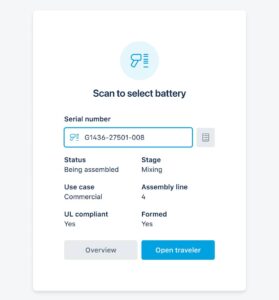In the last issue, we spoke about the importance of battery lot traceability, using the example of the Chevy Bolt recall. A full understanding of how a battery came to be is essential even long after it was manufactured. Clearly the burden on GM to recall every Bolt ever manufactured can be attributed to not having tracked which miscalibrated robots built which of the 40 million pouch cells that went into the entire fleet’s batteries.
While battery technologies and approaches may differ greatly among battery companies, they all benefit from a detailed accounting of how each serialized battery or cell is manufactured. In this issue, we’ll look at a real-life example of this unique approach to battery analytics by tracing the creation of a battery through the manufacturing line.
What a fully digital battery manufacturing capability looks like
When meeting with a new client, we first sit down to understand their build process and relevant quality measurement points and then configure the “digital manufacturing traveler” for their specific workflow.
Whether their process incorporates furnace ovens, 3D printers, welders, electrolyte mixing and fill machines, chilling stations, or automated test equipment, the digital traveler is set up to thread all steps into a comprehensive workflow that can be queried and assessed at any stage in the lifecycle.

Digitizing paper or spreadsheet data capture allows full data transparency and traceability at every level of detail, and guards against human error during data entry.
As the manufacturing workflow progresses, the traveler transitions through logical stages that reflect the optimal process for building each battery. Each stage must be formally completed before the next one can begin. Within a stage, there may be multiple steps that have to be completed in a particular order.
As operators complete each stage and step in the workflow, they sign off by providing their name and time of completion. This checkpoint, while seemingly trivial, is crucial in enforcing accountability. It also provides a way to track current status and time spent in each step and stage of the production line.
Unlike an MES, the digital traveler tracks the provenance of each cell and battery manufactured based on the serial number. This depth of tracking enables benefits such as smart warranties, streamlined recall scenarios and adherence to rigorous quality and safety standards.
Digitizing the battery manufacturing line – a real-life prismatic battery cell example

Every step of battery and energy block assembly is captured in the digital traveler to provide a complete build history and a single pane of glass into current status.
- At the start of each manufacturing shift, operators along the manufacturing line access the same data collection system at each station. In this example, the battery build process begins with a materials kit of anode and cathode plates and frames (or vessels) to be assembled, cell by cell, into serialized batteries. The digital traveler records the individual lots of the plates and frames in each kit, as well as subcomponents required in the electrode assemblies, such as glue, puck, and felt lots. If there is ever an issue with any of these subcomponents, the digital traveler provides full traceability to all the details per serialized battery (or cell).
Once the initial battery assembly is completed, a unique serial number is assigned. All automation metrics, ambient environmental conditions and specific equipment identifiers are now tied to the unique serial number and stored as part of the permanent history of the battery being manufactured.
Any battery across the installed base can later be located easily, should a manufacturing issue due to errant equipment or miscalibration be discovered later during in-field deployment. - As each newly formed battery exits the assembly stage with a unique serial number, the station operator reviews the traveler stage data. If everything looks fine, the battery goes to the next logical station.
From this point forward, as the battery moves down the manufacturing line, each station operator scans a bar-coded serial number label on the battery they’re working on to access the battery’s current step in the traveler. - At the next stage, the integrity of each newly assembled “dry” battery is verified. Automated test equipment checks for pressure leaks in the enclosure with per-cell measurements automatically extracted from the equipment and retained in the digital traveler. Thresholds are applied on each measurement to highlight batteries that may require rework in order to meet expected quality standards. Then the weight of each battery before and after automated electrolyte filling is recorded.
- At a final assembly and inspection station, operators are guided through a series of final installation procedures and checks. Local battery controllers are installed and wired, and final mechanical covers and cabling are completed. Operators verify that final product labeling is correctly in place, perform a visual inspection for cosmetic damage or defects or loose parts, and then confirm that all checks have been performed and the battery is ready for approval.
- Batteries are then combined into energy blocks that are likewise serialized with each assembly step recorded. Energy block controllers, cabling and integrated components are tracked by unique serial numbers or lot numbers. The final factory acceptance test and quality inspection is completed in the traveler and the energy block is approved for shipment.

IR badge scanning is used throughout for operator signoff to improve accuracy and speed/productivity. This ensures that start and stop transitions are registered along the line to determine real-time station queue and cycle times.
A floor supervisor may authorize an optional deviation tracking number to “temporarily” submit a stage or step where inputs fall outside of approved thresholds. Quality steps along the way are recorded, even if it’s simply the fact that a manual inspection was completed satisfactorily. In addition, granular line productivity metrics are generated and queue depths and throughput times for stations are reported.
The benefits of a fully digitized battery manufacturing line
Capturing exactly which components or material lots end up in which batteries provides a foundational and queryable data set. This capability in turn allows for comprehensive downstream analysis and tracking, covering anything from battery health and performance to safety.
If a specific machine is miscalibrated for a period of time or a particular component from a supplier is found to be faulty, identifying the affected batteries becomes a simple query — but only because the digital traveler was following each serial number through the entire manufacturing journey. What was once a potential huge headache for warranty or recall scenarios is now remedied by a process that happens automatically.
In this example, over 1,800 build and quality control parameters are captured per battery, automating the collection of 95% of battery assembly data. The kind of point and click analysis you would expect from a battery analytics platform is only useful if your data capture process is as robust as the one shown in this example.

